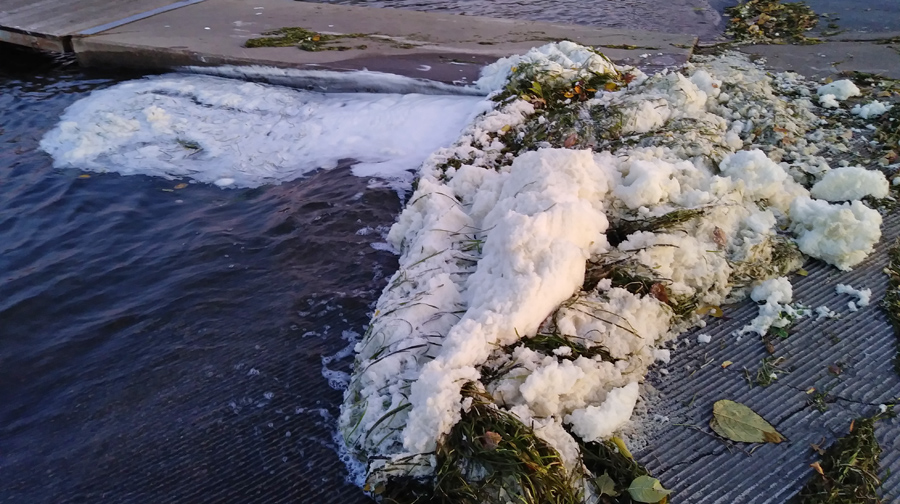State Officials Push Action on PFAS
50 state sites polluted. Evers budget includes $20 million to fight forever chemicals.

Foam present in Starkweather Creek in October 2019 shows elevated levels of PFOS and PFOA (PFAS chemicals). Photo from courtesy of the DNR.
Wisconsin’s top health official is emphasizing the importance of addressing contamination from PFAS chemicals and their effects on residents’ health.
During a webinar Monday with officials from the Department of Natural Resources, Wisconsin Department of Health Services Secretary Karen Timberlake said what environmental and health officials are learning about perfluoroalkyl and polyfluoroalkyl substances presents an “emerging frontier” that is a challenge to human health.
“The group of chemicals that we refer to as PFAS are extremely common,” said Timberlake. “They can have significant effects on human health. They really do represent another emerging frontier of a challenge to human health, not unlike COVID-19.”
PFAS contamination has been found at more than 50 sites statewide, including the Town of Campbell where thousands of residents on French Island were recently offered bottled water by the state due to well water safety concerns.
Most recently, state officials issued a fish consumption advisory for inland trout in Monroe County because of PFAS. The chemicals have also been found in deer liver near Marinette.
Gov. Tony Evers’ proposed budget includes $20 million in one-time DNR funding for the DNR to provide money for local communities affected by PFAS contamination, as well as 11 new positions to carry out the state’s PFAS action plan.
The DNR will soon be taking comments from the public on how much it would cost to implement standards meant to protect drinking water and groundwater, Johnson said.
More than two-thirds of Wisconsin residents get their drinking water from groundwater, and in November, state health officials proposed groundwater standards for 16 PFAS chemicals.
The federal government currently does not regulate PFAS as a hazardous substance.
Listen to the WPR report here.
State Officials Continue Efforts To Track PFAS Contamination was originally published by Wisconsin Public Radio.
More about the PFAS Problem
- MKE County: County Seeks to Sue PFAS Producers, Oil Companies - Graham Kilmer - Dec 10th, 2025
- Wisconsin Reviewing EPA-Approved Pesticides For PFAS - Danielle Kaeding - Dec 9th, 2025
- State Nears Settlement with Johnson Controls/Tyco Over PFAS Spills - Danielle Kaeding - Dec 4th, 2025
- Senate Bill Promotes Soybean-Based Firefighting Foam to Replace PFAS - Danielle Kaeding - Dec 2nd, 2025
- Test Results Show High PFAS Levels in Wisconsin’s Landfill Runoff - Danielle Kaeding - Dec 2nd, 2025
- Wisconsin Communities Get $282 Million for Drinking Water Projects - Danielle Kaeding - Nov 19th, 2025
- Gov. Evers, DNR Announce $282 Million to Improve Drinking Water Quality for Wisconsinites in 74 Municipalities - Gov. Tony Evers - Nov 18th, 2025
- Cleanup of PFAS Could Cost Wisconsin Billions - Danielle Kaeding - Nov 13th, 2025
- Cleanup PFAS Without Penalizing Innocent Landowners - Wisconsin Manufacturers & Commerce - Nov 4th, 2025
- Wisconsin Lawmakers, DNR Clash Over PFAS Protections in GOP Bills - Danielle Kaeding - Oct 8th, 2025
Read more about PFAS Problem here





















